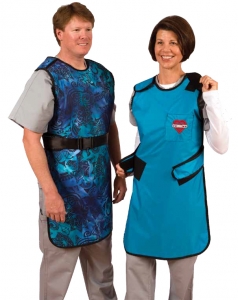Lead Aprons For Radiation Protection
Lead protective equipment is an essential tool for protecting staff during X-ray exposures. Lead aprons are an important piece of radiation protection equipment that are designed to attenuate ionizing radiation. It is recommended that protective lead aprons offer a minimum of 0.25 mm lead equivalent, check your state’s regulations for specific requirements on lead equivalency.Commonly, the minimum requirement of lead equivalency for an occupational worker not standing in the primary beam is 0.25 mm. Lead aprons cover approximately 75% – 80% of a person’s active bone marrow. The amount of attenuation provided by a lead apron will depend on several factors including the overall physical condition of the lead within the apron, how it is worn, the lead equivalency of the apron, and the energy (kVp) of the x-ray beam.
Percentage of Ionizing Radiation Blocked by Lead Aprons (kVp’s)
0.25 mm lead equivalent (Pb) offers the following levels of protection at the selected kVp’s:
- 97% at 50 kVp
- 66% at 75 kVp
- 51% at 100 kVp
0.50 mm lead equivalent (Pb) offers the following levels of protection at the selected kVp’s:
- 99.9% at 50 kVp
- 88% at 75 kVp
- 76% at 100 kVp
Peak Kilovoltage (kVp)
kVp– Peak kilovoltage is the maximum voltage applied across an x-ray tube. It determines the kinetic energy of the electrons accelerated in the X-ray tube and the peak energy of the X-ray emission spectrum. The actual voltage across the tube may fluctuate.
Radiation Exposure Reduction
Lead aprons provide a significant reduction in radiation dose to staff during procedures that require the use of x-rays.
By using lead aprons, diagnostic x-rays are absorbed by the lead and not the parts of the body that are shielded by the apron. The Health Physics Society states that the effectiveness of lead aprons is energy dependent but averages around 90-95. “Leaded aprons are worn as good radiation safety practice and in keeping with the ALARA (as low as reasonably achievable) concept.”
Wearing radiation protection lead aprons greatly reduces an individual’s exposure to radiation. There are two main types of lead aprons available, each with their own unique qualities and benefits.
Regular Lead Aprons
The first type is the regular lead apron which contains 100% lead making it the heaviest apron available.
Lead Composite Aprons
The second type of lead apron is the lead composite apron. Available in Xenolite lightweight lead composite and ultra light lead composite this type of lead apron utilizes a blend of lead and other lighter weight attenuating metals, resulting in a 25% lighter option compared to the regular lead aprons.
Quickship Lead Aprons
Unlike our custom lead aprons that are made to order, the quickship lead apron offers fast turnaround when customization is not required.
How To Properly Store Your Lead Apron
Hanging lead aprons properly is an important safety consideration. Always hang lead aprons on approved hangers and hooks. Improper storage of lead aprons can not only damage the lead apron, but it can also put you at risk for increased radiation exposure. The best solution for storing lead aprons is to use an appropriate lead apron rack. There are a wide-variety of lead apron storage options available including wall mounted peg style lead apron racks, mobile lead apron racks, wall racks with movable arms, multi-apron and glove rack, garment style apron storage racks, and combination apron and glove holder racks.
How To Care For Your Lead Apron
By learning the proper way to maintain and care for your x-ray apron, you will ensure that you are properly protected from radiation exposure. When you care for your apron you are not only protecting yourself, you are also protecting your investment. There are several rules that you will want to follow to get the most out of your lead apron, learn more by reading our post on the X-Ray Protective Apron Care: 9 Do’s and Don’ts.
When Is It Time For A New Apron?
How To Properly Dispose Of Your Retired Lead Apron
Although lead does an excellent job blocking radiation, it can be harmful to the environment if not properly disposed of. It’s important to note that regulations and requirements regarding disposal methods can vary by state. For more information, take a look at our blog post on 3 Ways To Discard Your Retired Lead Apron.
